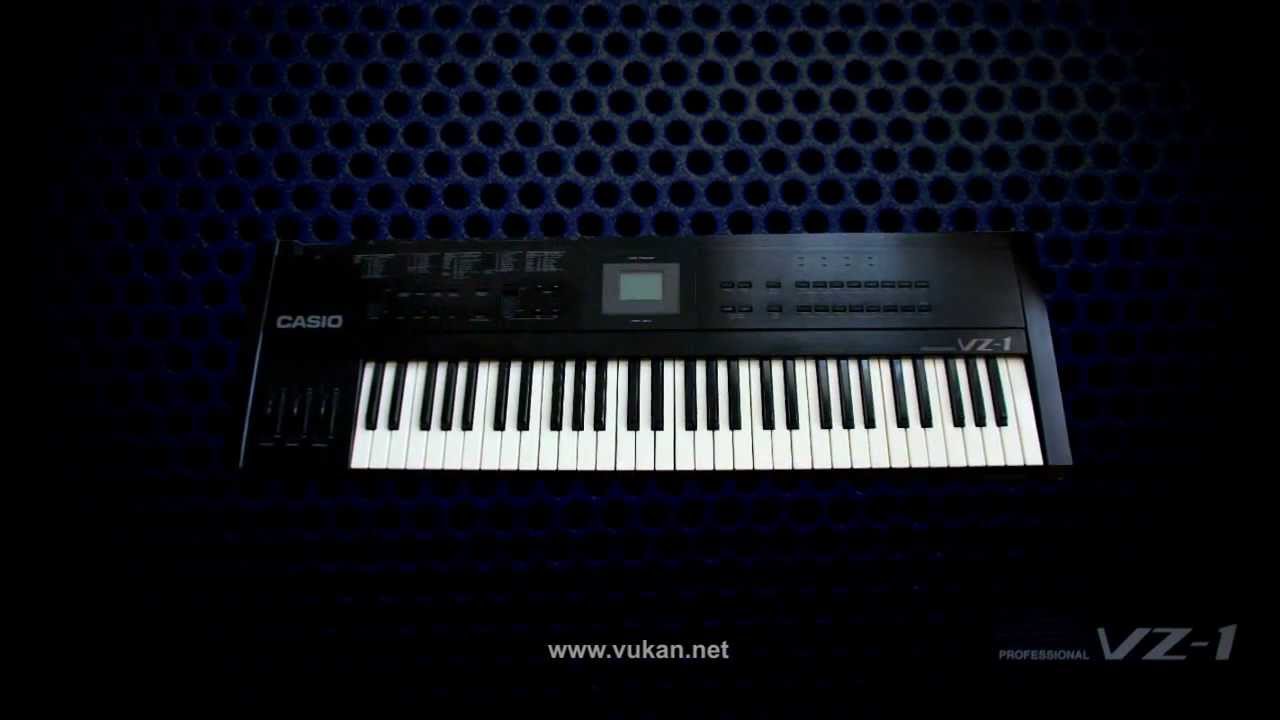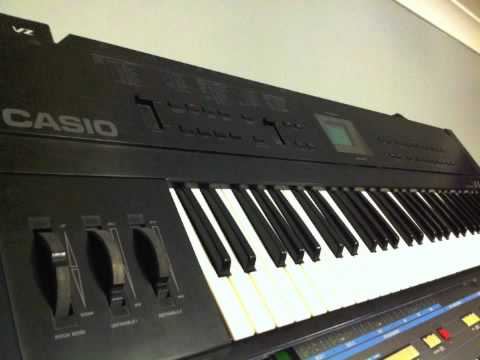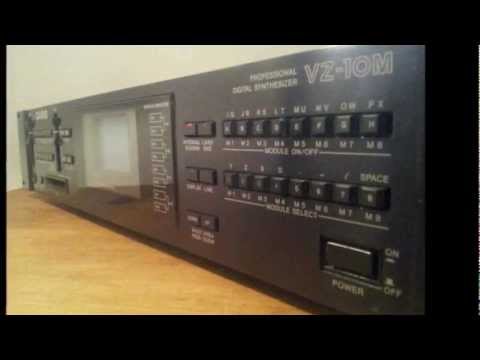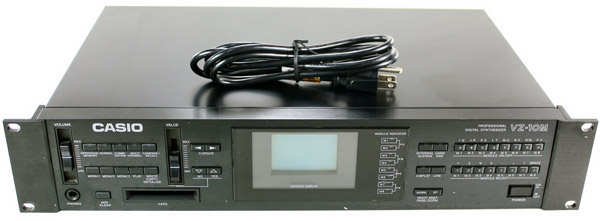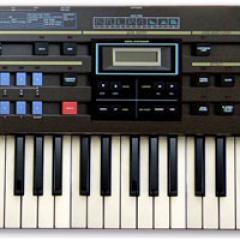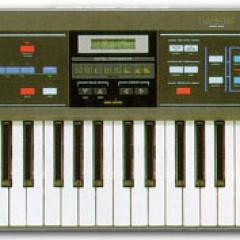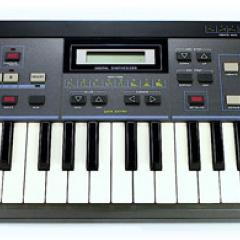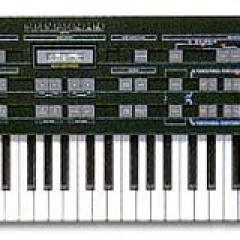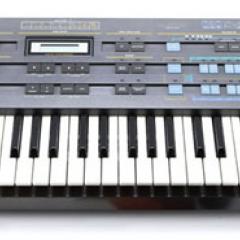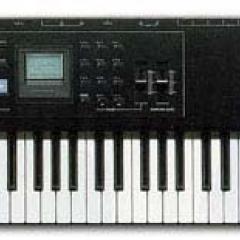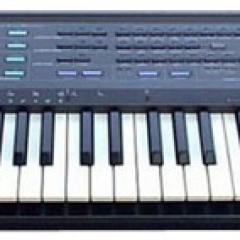Casio VZ-1

The Casio VZ-1 was released in 1988 hot on the heels of the successful CZ line and became Casio's flagship synthesizer, replacing the CZ-1 at the top end and going flat out to town with the feature list, easily putting it toe to toe with products from Yamaha, Roland and Korg. The case design also reflected a more professional approach that Casio was taking; a sleek and minimal all black design free from clutter with a brushed steel front plate, making it a very impressive unit to look at - it is also very well built having an all metal chassis, yet maintains a relatively light weight making it especially good for gigging.
The first notable departure from the CZ line is the programming interface, replacing analog-like button per function programming with a page driven system similar to that of the FZ-1 released the previous year. The large (for the time) backlit dot matrix graphic LCD display made programming this synthesizer far easier than Yamaha's DX7 and DX7-II; envelopes and signal path, for example, were edited graphically rather than a number at a time and in text only mode and several parameters were viewable on screen at once. Unlike other synthesizers on the market at the time, the edit pages were not nested and their location and function were clearly marked on the front panel above the menu and function buttons.
The VZ-1 takes a hybrid approach to its sound generation. Where the CZ line used Phase Distortion Synthesis and the Yamaha DX line used Phase Modulation (incorrectly advertised as FM), the VZ-1 uses Phase Distortion for ring modulation and waveform generation but true Frequency Modulation Synthesis to generate harmonics. The end result is a unique and hauntingly space-age sounding synthesizer with many smooth "twangy" textures - but it can also be very harsh and noisy when complex phasing is employed. Thumping bass-lines and sweeping pads are its strongest points but it is also very capable of analog-ish brass and strings.
The Casio VZ-10M rack mount
The voice architecture is similar to the Yamaha DX synthesizers in that you have several oscillators that link together to generate extra harmonics via some form of algorithm. Where the DX7 has six oscillators to choose from, the VZ has eight. Each oscillator is part of a "module" and each module has a long list of functions independent of the other modules: Waveform, detune, envelope, envelope depth (that also functions as oscillator volume), envelope velocity sensitivity, envelope key follow and amplifier sensitivity. Each module is then arranged in 4 pairs: A, B, C and D. The first module in a pair then has the option to mix with the second module (similar to a dual oscillator synthesizer), ring modulate the second module or phase modulate the second module. The output from this can then be sent to the main output, or used to modulate the second module of the following pair (for example: the output from Pair A modulates the second module in Pair B which is also being ring modulated with the first module in Pair B). This freedom to pick and choose your own voice combinations allows for some very wild and complex sounds.
Aftertouch was also rather generous for the time too, allowing modulation of vibrato depth and rate, tremolo depth and rate, portamento time, pitch modulation and envelope bias.
The VZ-1 also features a combination mode that lets you stack up to 4 patches on top of each other giving a total of 32 oscillators per voice. Working in combination mode does lower polyphony, however, with 4 patches only allowing monophonic operation. Each patch in a combination could then be velocity switched, velocity triggered, crossfaded, have their tremolo and vibrato inverted, detuned, transposed and split across the keyboard. Even today, this is an impressive list of features for a non-workstation synthesizer. The keyboard also has two outputs that come in great use when controlling over MIDI or when playing split. Some careful trickery with Tremolo in combination mode with these two outputs can also give you a stereo panning effect.
There are some drawbacks, however. Where other synthesizers of the time could store up to 128 patches in memory, the VZ only has 64 (8 banks of 8 slots) and the ROM cards were limited to a max of 64 patches due to the way the front panel was laid out. The synthesizer does not contain any onboard effects or a sequencer and the presets are of the typical cheap Japanese keyboard affair - with the only usable patches out the box being the DX7-ish slap bass guitar and e-piano.
Although easy to program, especially when compared to a D-50 or a DX7, the long list of parameters that need to be edited for each individual module make this synthesizer very tedious to program larger sounds and textures. Add on the complexity of its sound engine and how twitchy it can be and it may end up frustrating to those not well versed in synthesizer technology.
Despite these failings, the synthesizer is still bewilderingly powerful and versatile if you spend time to become better aquaintted with it and it can easily become the focal point of any track with its uniquely warm yet cutting tonality. They do often spring up at low prices but have been increasing in popularity recently; some units in good condition can fetch up to £400, more-so if an RC-100 ROM Card is included.
Update: Unlike the Yamaha "FM" synths, the VZ-1 or VZ-10m can be stacked under multiple VZ-8m modules (six max.) for up to 64 independent voices of polyphony, which is 512 oscillators/operators total, double that of the also-amazing Kurzweil K150 additive synthesizer (240 partials.) The TX816 can provide up to 128 voices and can currently be had for about $1000 on eBay. The VZ still has better audio and more versatile algorithms.
Demos & Media
